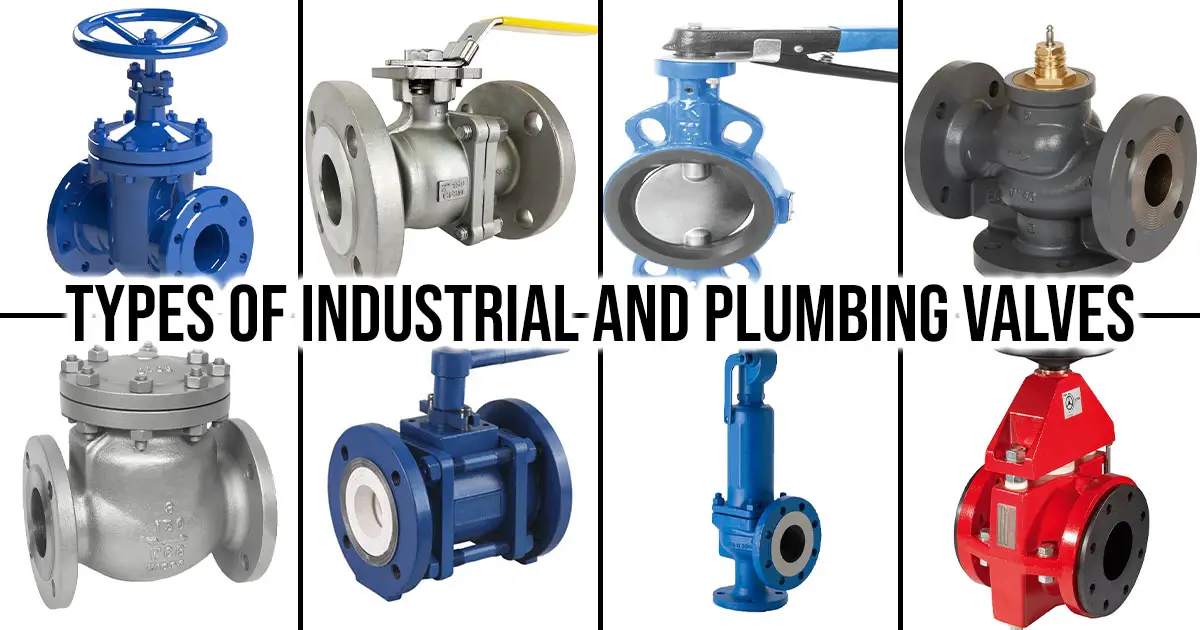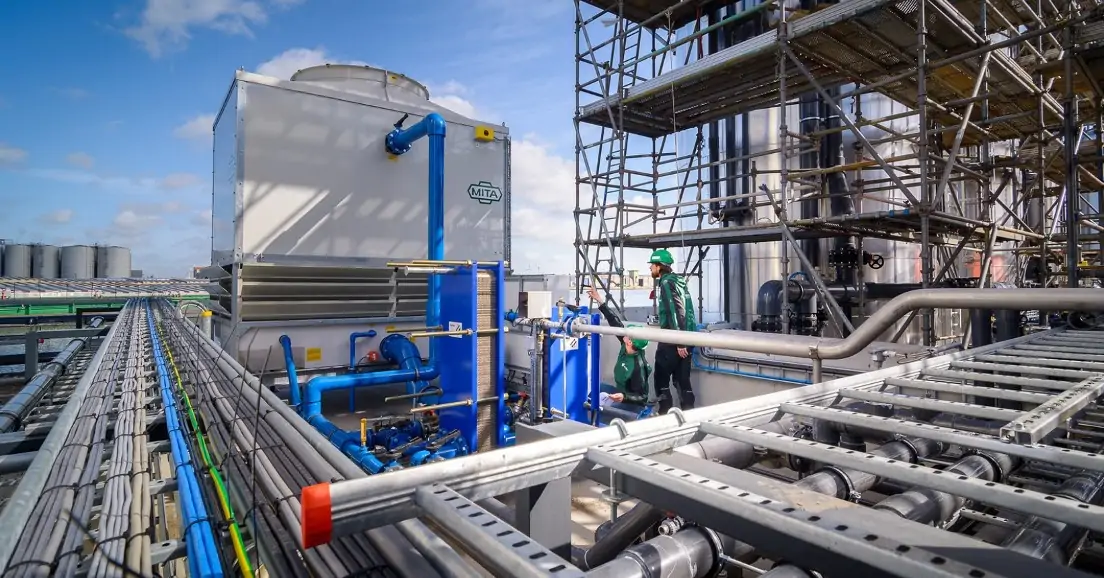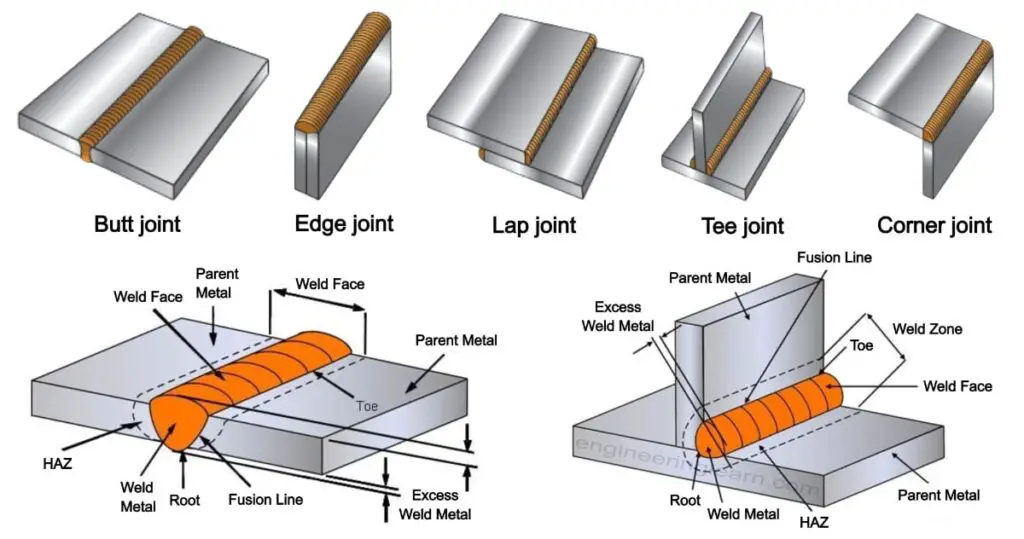What is Valve?
Valves are mechanical devices that open, close, or partially restrict the flow of water to control, direct, and regulate it. They can be made of many materials such as bronze, PVC, brass, etc. Valves have several applications, including managing irrigation water, industrial process control, and household applications such as on/off and pressure control to dish and clothes washers and taps in the home.
Romans made the first valve from bronze. They were sturdy and welded to existing pipes. The body had a holey stopper, bottom support, and a long lever to spin it. Our Roman ancestors were wise to build water systems for ancient towns.
The Industrial Revolution helped build the contemporary valve. Thomas Newcomen’s 1705 steam engine was a notable engineering achievement. He needed new, better valves for high-pressure steam.
In the 18th and 19th centuries, during the Industrial Revolution, valves were designed and made faster so they could keep up with the needs of industry. In the second half of the 20th century, when more advanced manufacturing techniques and more exotic materials that could handle the high pressures and temperatures of the new, better fluids became available, these designs were improved.
Types of Valve Used In Industries and Plumbing:
A wide range of valves and valve configurations fit all services and situations, including varied purposes, fluids materials, and pressure and temperature conditions. In fluid or gaseous handling applications, valves initiate or stop the flow, regulate or throttle flow, prevent backflow, and relieve and regulate pressure. Following are the different types of valves used in Industries and Plumbing:
- Gate Valves
- Ball Valves
- Butterfly Valves
- Globe Valves
- Check Valves
- Plug Valves
- Pressure Relief Valves
- Needle Valves
- Pinch Valves
1. Gate Valves:
The gate valve is the most common form in plumbing systems. It has a wedge-shaped metal gate that may be lowered to stop the flow of water or enable the flow to continue (through a twist-type lever or knob). Because gate valves are designed to be fully open or fully closed, they cannot control water flow. It can wear out the valves if used to alter the water flow. Gate valves can circulate fluid, including air, fuel gas, feed water, steam, lubricating oil, and hydrocarbons.
It operates by twisting the handle wheel clockwise and anticlockwise to move a rectangular or circular gate connected by a stem out of the course of the fluid. The gate or wedge moves up and down across fluid flow when the wheel with the handle is spun.

Courtesy: freepik.com
Turning the handle wheel clockwise causes steam and water to go downhill across the fluid flow and the gate to be compressed between two seats. So that when the valve is entirely closed, there is no fluid escape. When you turn the handle Wheel anticlockwise, steam and fluid rise over the fluid flow simultaneously. When the valve is in the Chrome closed position, fluid flows via the Gate valve.
This energy causes the gate valve wedge to move lower or upward. An extension spindle is linked to underground gate valve installations, allowing operation without direct access to the valve.
Types of Gate Valves:
Gate valves are classified into the following categories based on their construction:
A. Types of Gate Valve Based On Disk:
Solid Wedge Gate Valve:
Since it is easy to make and strong, the solid wedge is the most common and widely used type of disc. Wedge-type gate valves have a wedge-shaped disc that fits between two inclined seats. A solid wedge valve can be put in any position. Solid wedges, like steam service, are used in applications with high flow or turbulence. The vibration and noise were also kept to a minimum by the solid design.

Courtesy: tfwvalve.com
Flexible Wedge Gate Valve:
A flexible wedge is a solid disc with a circumferential groove. A small, narrow incision minimizes flexibility while preserving strength. Cast-in recess or deeper, wider cut on wedge periphery adds flexibility but loses strength.
It improves seat alignment and leak-tightness. Thermal binding improved performance. Bend ability Steam uses gate valves. Steam line expansion can distort valve bodies, causing thermal blindness. The flexible gate stretches as the steam pipeline valve seat compresses, preventing thermal blindness.

Fig 3: Flexible Wedge Gate Valve
Courtesy: petal.ro
Parallel Disc or Flexible Edge Gate Valve:
A unique mechanism holds the Split Wedge Disc’s two solid sections together. If half the disc is off, it can still fit the seat. The split disc might be wedge-shaped or flat.

Courtesy: flickr.com
Spring-held parallel discs always seal in both directions because they touch the seats. The split wedge may transfer gases and liquids at normal and high temperatures. If the disc can move, thermal binding won’t occur even if the valve is closed and the line is cold. It means that heating a line doesn’t produce thermal blindness.
B.Types of Gate Valve Based on Body, Bonnet Connection:
Screwed Bonnet: It is the most basic design available and is used for low-cost valves.
Bolted-Bonnet: It is the most common design and is found in most of the gate valves. A gasket is required to seal the junction between the body and the bonnet.
Welded-Bonnet: This is a popular design that does not require disassembly. They are less heavy than their bolted-bonnet equivalents.
Pressure-Seal Bonnet: Such kind is often utilized in high-pressure, high-temperature applications. The greater the force on the gasket in the pressure valve, the greater the pressure in the body cavity.
C. Types of Gate Valve Based on Stem Movement
Rising Stem Gate Valve with Outside Screw:
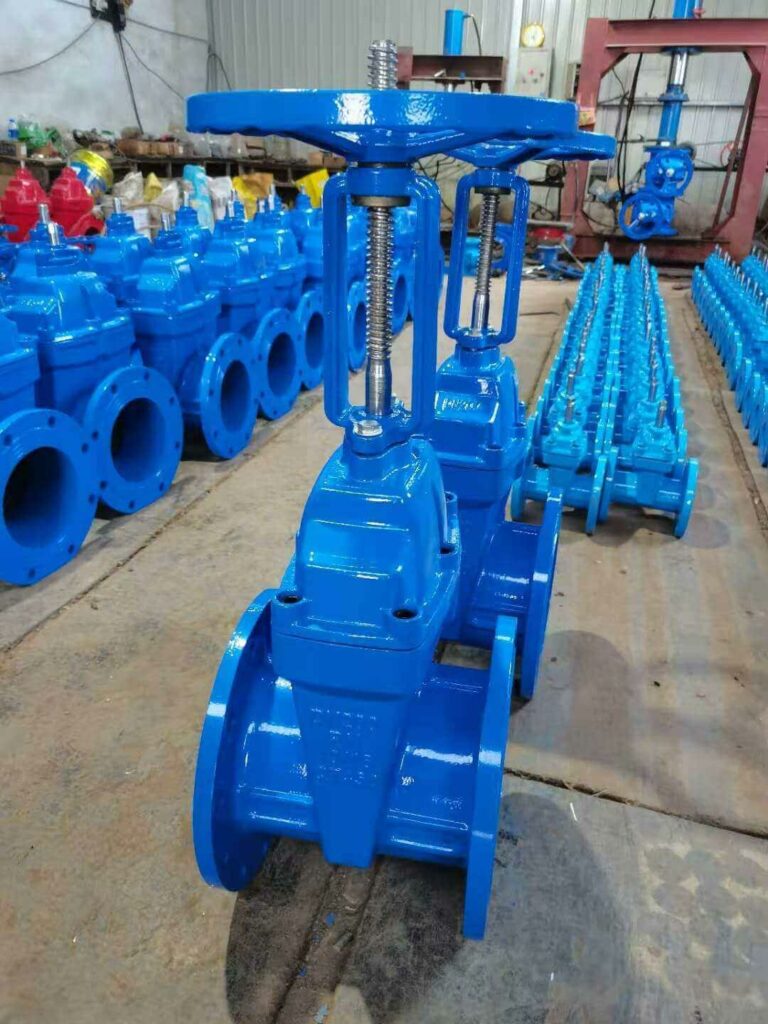
Courtesy: tanghaivalve.com
A rising stem valve rises when opened and descends when closed. In an inside screw configuration, the threaded stem is in contact with the flow medium, and when the valve opens, the hand wheel rises with the stem. With an exterior screw design, the smooth stem is exposed to the flow medium, and steam rises over the hand wheel. This valve is an OS & Y. Outside steam and York is abbreviated OS&Y.
Non-Rising Stem Gate Valve:
A non-rising stem type has no upward movement of the stem. The valve disc is internally threaded. When the stem is spun, the disc moves along it like a nut. The image is visible. The stem threads of this type of valve are exposed to the flow media.

Courtesy: tfwvalve.com
As a result, this design is used when space is restricted, and the flow medium does not cause erosion, corrosion, or wear and tear on the stem material. An inner screw valve is another name for this sort of valve.
Gate Valves Usages:
- Gate valves are employed in every fluid service, including air, fuel gas, feed water, steam, lubricating oil, hydrocarbons, and many others.
- Some unique gate valves, such as knife gate valves, are also employed in slurry and powder products.
Gate Valve Pros:
- Gate valves do not stop water flow since the wedge can retract completely for uniform flow.
- Because gate valves open and close slowly, water flows or stops gradually, reducing pressure and noise in the unoccupied pipes that follows.
Gate Valve Cons:
- A gate valve operates slowly. Opening and closing take time, which is beneficial since it decreases the possibility of hammering
- It cannot be used to regulate the flow.
- .It produces vibration and noise when partially opened.
- Due to limited access, repairs such as seat lapping and grinding are more difficult.
2. Ball Valves:
A ball valve is a quarter-turn rotational motion valve that stops the flow with a ball-shaped disc. In many aspects, it is similar to a plug valve. The ball enables flow when it is in a port line. When the valve is rotated 90 degrees, the solid part of the ball blocks the flow.

Courtesy: vastas.com
Most ball valves are quick-acting, requiring a 90-degree rotation of the valve handle to activate. Gear-driven actuators, on the other hand, are utilized for larger-sized valves that require significant force to open or close. A little hand well is sufficient to operate a large valve in this configuration.
Ball valves can have many ports, which are the valve’s apertures. Two-way ball valves with two ports are utilized for traditional on/off control. Multi-port valves (three-way, four-way, and so on) are used in applications that require more than one media source or media to be deflected in multiple ways.
A ball valve’s port can be opened or closed manually or via actuation to control media. Controlling the valve requires handles or levers and an operator. Electric, hydraulic, and pneumatic actuation do not necessitate the use of a human to control the valve. Actuation is appropriate for complex control systems or remote locations where an operator cannot easily access them.
Types of Ball Valves:
Floating Ball Valve:

Courtesy: ogvuk .com
Two elastomeric chairs hold the floating ball in place. It floats. The stem attaches to a ball’s slot, allowing it to turn a quarter-turn (90 degrees). The shaft lets upstream pressure move the ball laterally. This slight lateral movement improves leak tightness by forcing the ball into the downstream seat. Bidirectional valve. Upstream pressure makes the floating valve difficult to operate.
Trunnion Mounted Ball Valve:
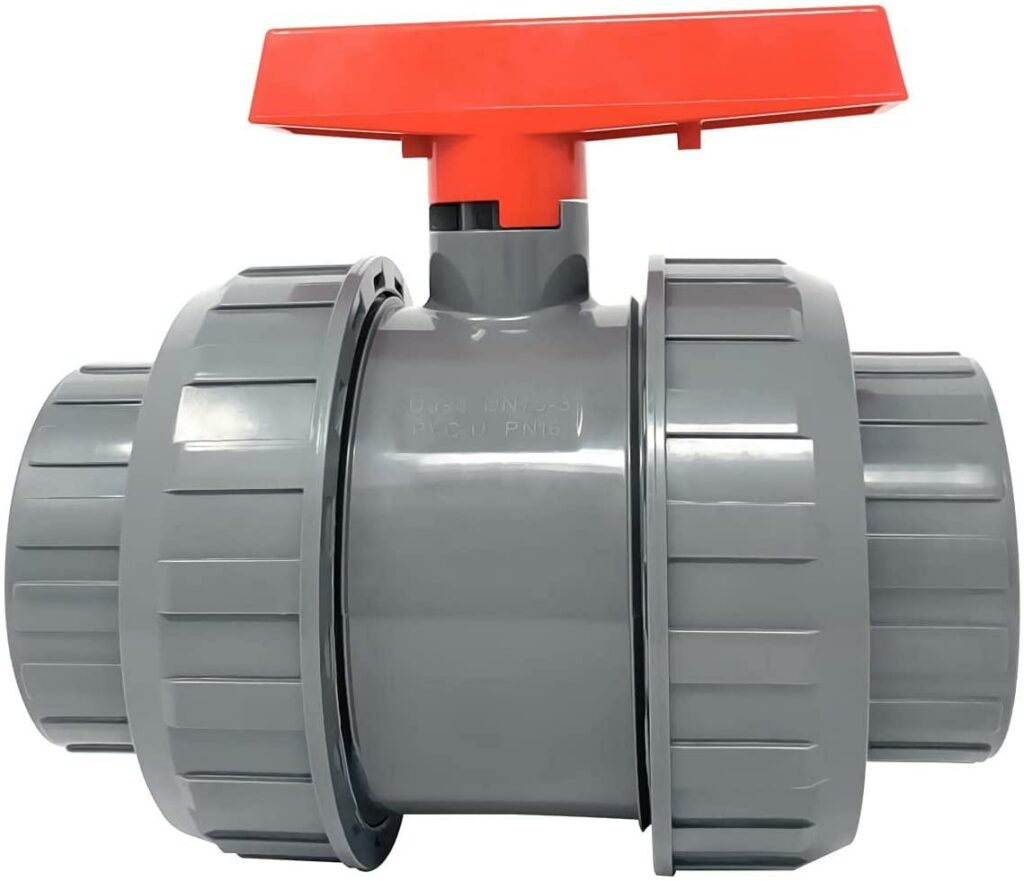
Courtesy: ubuy .com
High-pressure floating valves demand considerable torque. A trunnion is a body-mounted shaft. This design combines steam and ball. Two spring-loaded or floating chairs support the ball.
Trunnion balls require minimal torque. Reduces actuator size and valve cost. As pressure class and valve size grow, this cost difference becomes crucial.
3 Way Ball Valve:
A three-way valve port can be set up depending on your needs.
i) There was one inlet and two deliveries.
ii) Changing a flow with an inlet and an outlet
iii) Without an inlet, the fluid passes straight through.
There are three types of ports: venturi, full, and low. Full-port ball valves have an internal diameter equal to the pipes inside diameter. Pigging is possible with this design. The port in venturi and low-port kinds is normally a pipe size smaller than the line size.
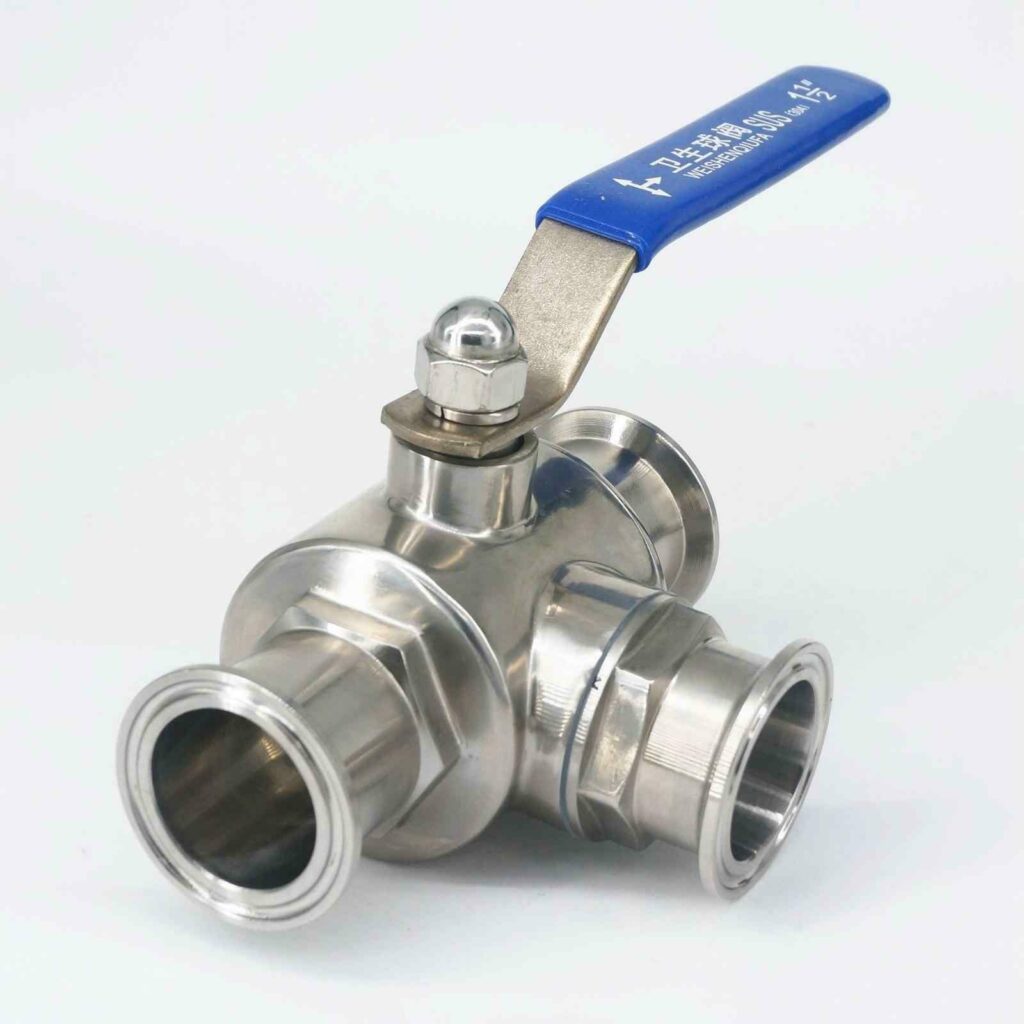
Courtesy: kinvalve.com
Split-Body Ball Valve:
There are two or three components to a valve’s body. The bigger body section contains a ball, seat rings, stem, and other internals that are bolted together with smaller parts.
Ball Valves Usages:
- It can be utilized as an on-off stop valve with bubble-tight shutdown in various fluid services.
- Metal-seated valves are suitable for high-pressure and high-temperature applications.
- It is suitable for air, gaseous, vapor, and hydrocarbon services.
- It is commonly used to connect instruments with instrument tubing.
Ball Valve Pros:
- It is an easy-to-open and close type that delivers reliable bubble-tight sealing in high-pressure temperature applications.
- Several ball valve designs provide selection versatility, allowing you to select the valve that best meets your needs.
- It is smaller and lighter than a similar-sized and rated gate valve.
- Maintenance is simple and inexpensive.
Ball Valve Cons:
- It can’t be throttled.
- Suspended particles can settle in slurry or similar applications, producing wear, leakage, or valve failure.
- Surge pressures from quick opening and closure might damage downstream equipment.
3. Butterfly Valves:
Another form of shutoff valve extensively used to segregate and regulate water flow is the butterfly valve. A butterfly valve has a spinning disc in the center. Like ball valves, this movable element is controlled by a quarter-turn of a lever. When the handle is turned, this plate flares open, allowing fluid to flow through the pipe.

Fig 10: Butterfly Valve
When the disc is closed, no fluids are allowed to move. The “rotary motion” valve family includes butterfly, ball, and plug valves. They manage flow by deploying a rotating device that initiates flow closure. Because they are so small, light, and short, these valves are substantially lighter than the others.
Types of Butterfly Valves:
Water Types:

Courtesy: ksb.com
The flange bolts surround the wafer-type butterfly valve body. The cheapest butterfly valve. Long bolts cover the valve body and flanges. Wafer butterfly valves seal bidirectional fluid flow pressure differences. Wafer-style butterfly valves guard against tight seals and two-way pressure differences.
Lug Style:
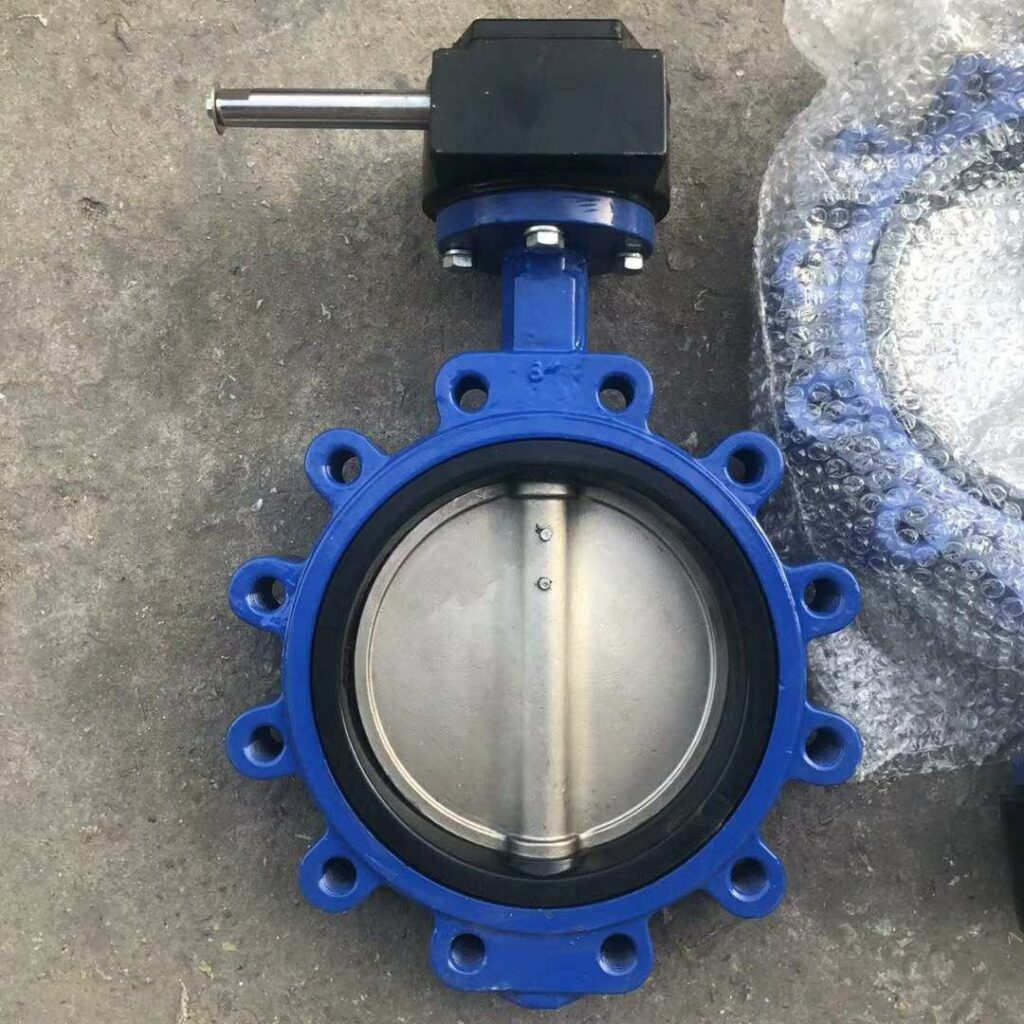
Courtesy: motor-operated-valve.com
The retracting body comprises a series of lugs around the body’s perimeter that give way to bolt holes that correspond to those in the flanges.
Flanged Type:

Courtesy: avkvalves.au
The body of this type correlates to the pipe’s flange dimension.
Butt Welded Ends Types:
These ends are welded directly onto the pipe and are utilized in high-pressure services.
Zero offset Butterfly Valve:
Low-pressure and temperature valves have zero offsets, and the disc and shaft axis is concentric with the valve body. The disc divides the flow into two equal parts in an open position.
Double Offset Butterfly Valve:
Double offset smooth opening and closing since friction is applied only during the initial few degrees of opening. The final few degrees of closure are 10 degrees after opening and closing.
Triple Offset Butterfly Valve:
The third offset is formed by the geometrical design of the sitting surface in the Triple Offset design.
Butterfly Valves Usages:
- Butterfly valves are used in a variety of fluid services and also work well in slurry applications. They have applications in liquids, steam, cryogenics, cooling water, air, gases, firefighting, and vacuum services.
- Butterfly valves are utilized in many sectors, including high-pressure and temperature applications.
Butterfly Valves Pros:
- Butterfly valves are ideal for big valve applications due to their compact, lightweight design, which takes up far less space than conventional valves.
- A butterfly valve has a tiny pressure drop.
- Non-metallic seating valves can be utilized in chemical or corrosive fluids.
- It takes less time to open or close because of the rapid operation.
- Maintenance costs are often cheap when compared to other valve types.
Butterfly Valves Cons:
- Throttling is only available at low differential pressures.
- Flow turbulence has an impact on disc movement.
- Cavitations and clogged flow are possible outcomes.
- Even in an open state, the valve disc is constantly under pressure and might interrupt the flow.
- The sealing function is poor.
- High differential pressure is not recommended.
4. Globe Valve:
The globe valve is a linear motion plumbing valve used to stop, start, and control flow. The globe valve disc can be withdrawn from the flow passage or completely closed the flow path. The disc moves perpendicular to the seat as the valve opens and closes.
The globe valve seat leaks less than the gate valve seat, owing to the right-angled contact between the disc and the seat ring, which allows for tight sealing between the seat discs.
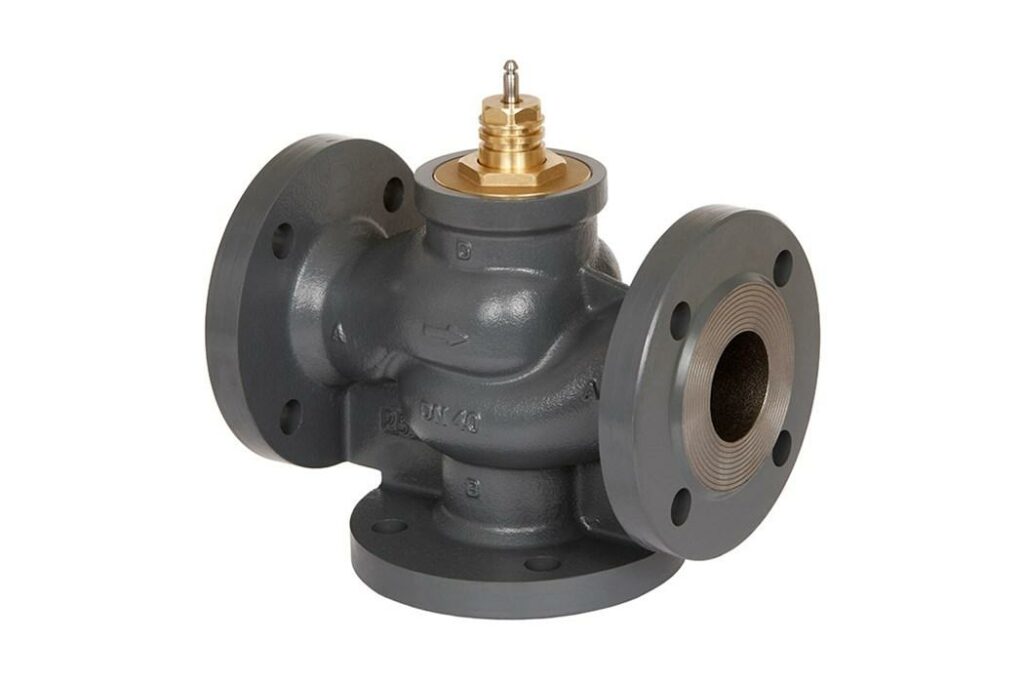
Courtesy: danfos.com
Types of Globe Valve:
Angle Types Globe Valve:

Courtesy: hawavalves.com
Without an elbow or an extra pipe weld, an angle globe valve can change the flow direction by 90 degrees. Against the flow, the disc is opened. Because they can handle the slugging effect, this type of globe valve can also be employed in a variable flow situation.
Z Types Globe Valve:

Fig 14: Z Types Globe Valve
Courtesy: sabdejlah.com
A Z-body is a simplest and most popular design. Seats are located inside the circular body of Z-shaped dividers. The seat’s horizontal sitting configuration allows the stem and disc to travel perpendicular to the pipe’s axis, causing excessive pressure. The valve seat is easily accessible through a big aperture at the top of the valve body, which is connected to the bonnet.
Y Types Globe Valve:

Courtesy: sino-freede.com
The Y-type design solves the problem of high-pressure drops in Z-type valves. The seat and stem are inclined at approximately 45° to the pipe axis in this design. Y-body valves are utilized in high pressure and other important services with a concern about pressure decrease.
Globe Valves Usages:
- It is utilized in high-point vents and low-point drains where critical leak tightness and safety. Otherwise, a gate valve can be used to drain and vent.
- This valve is sometimes used as an automatic control valve, but an actuator assembly lifts its smooth stem.
- It can be used in feed water, chemical, air, lubricating oil, and practically any other service where pressure drop is not an issue.
Globe Valves Pros:
- Closed more effectively than the gate valve
- Because the seat and disc can be accessible from the valve top, it’s simple to fix.
- It’s ideal for continual use because there’s no risk of the seat or disc wearing out
- Because of the shorter stroke length, it operates faster than a gate valve.
- Typically, an automated actuator loss is used.
Globe Valves Cons:
- Two right-angle twists of flowing fluid within the valve body cause high head loss.
- Obstructions and discontinuities cause a high head loss in the flow route.
- A huge valve requires a lot of electricity to open and make noise while running.
- Pulsations and collisions in a large high-pressure line can harm internal trim parts.
- It weighs more than other valves with the same pressure rating.
- More expensive than the gate valve.
5. Check Valves:
A check valve is a device that permits fluids to flow exclusively in one direction. They have two ports, one for media ingestion and one for media output. Because they only allow material to flow in one direction, they are sometimes known as ‘one-way valves or ‘non-return valves.’ A check valve’s primary function is to prevent backflow in the system.
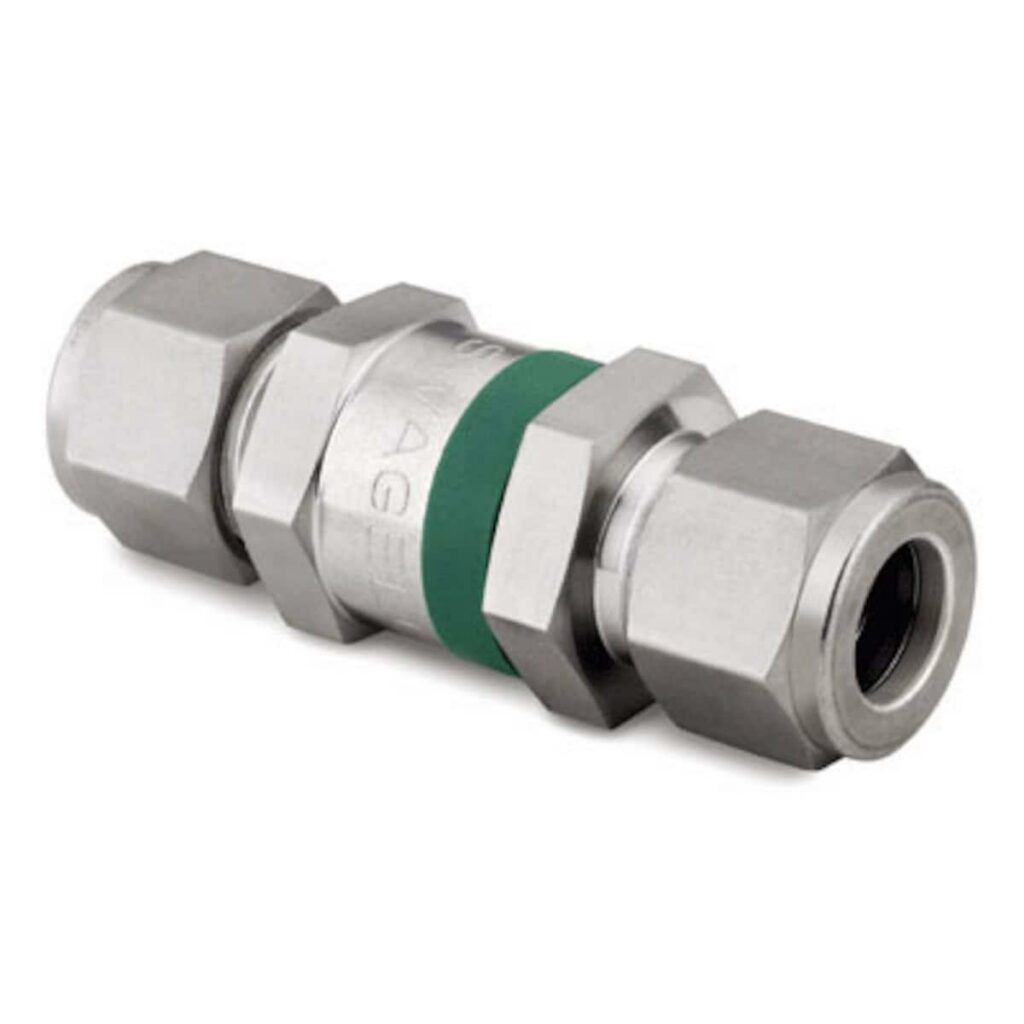
Courtesy: products.swagelok.com
A check valve requires a pressure differential to function. Opening the valve requires more pressure on the input side than on the output side. The valve closes when the pressure on the output side is too high (or the pressure on the input side is insufficient). Depending on the type of valve, the closure mechanism differs. Unlike conventional valves, they do not require a handle, lever, actuator, or human to function properly.
Types of Check Valves:
Swing Check Valve:
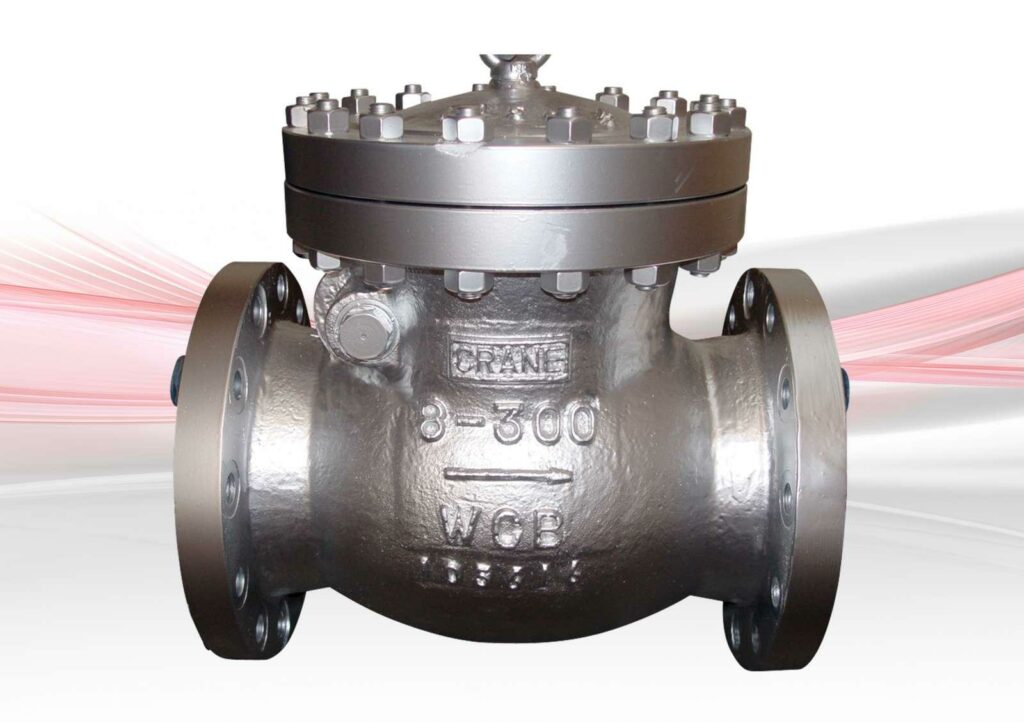
Courtesy: cranefs.com
Interlocking discs open and close fully on swing valves. If there is flow in the line, this valve opens; otherwise, it closes. It has negligible turbulence and pressure drop. There is metal, two metal discs, and seat styles, and 5 to 7 degrees is the standard seat angle. Larger seat angles reduce disc travel, water hammer, and speeding disc closure. A vertical seat is horizontal.
Tilting Disc Check Valve:
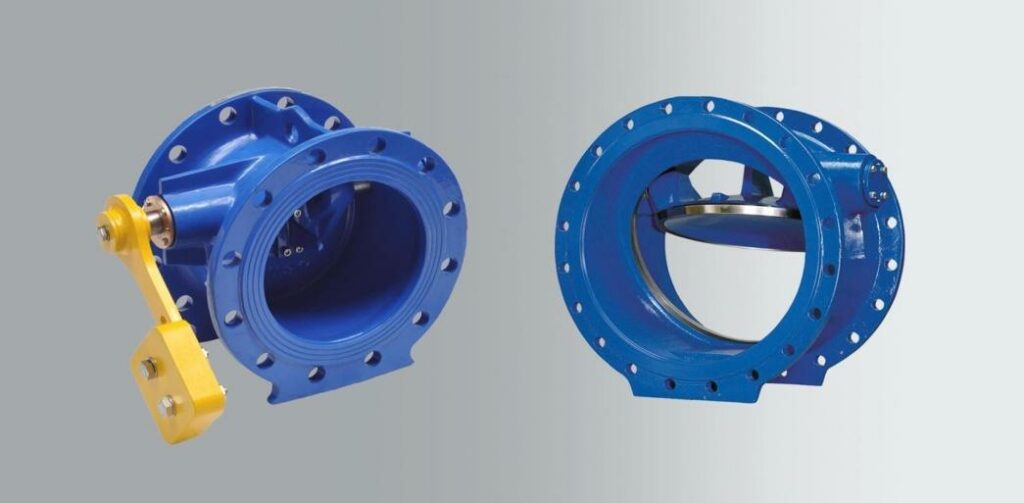
Courtesy: avkvalves.eu
The tilting disc valve overcomes the shortcomings of conventional swing valves. The tilting disc design allows the valve to open fully at low flow rates and close rapidly when the flow stops. Both the bottom and top of the dome-shaped disc float in fluid flow. The spring-loaded disc helps seal the valve quickly when forward flow pressure drops.
Ball Check Valve:

Courtesy: avkvalves.eu
Ball check valves limit the flow by moving a ball up and down inside the valve. The valve seat is contoured to suit the ball and features a conically formed chamber that guides it to the seat. The ball’s weight varies based on the pump’s capacity and the risk of water hammer.
Stop Check Valve:

Courtesy: avkvalves.eu
Stop check valves are Y check valves with springs. This valve’s manual override function allows it to override and keep the valve open or closed. This valve has two uses. To override, use a lever or wheel. These valves are utilized in steam generators, turbines, and safety equipment in power plants.
Piston Check Valve:
A piston check valve is similar to a lift check valve because it allows fluid to pass through it. It has a dash-pot made up of a piston and cylinder and acts as a cushion during operation.
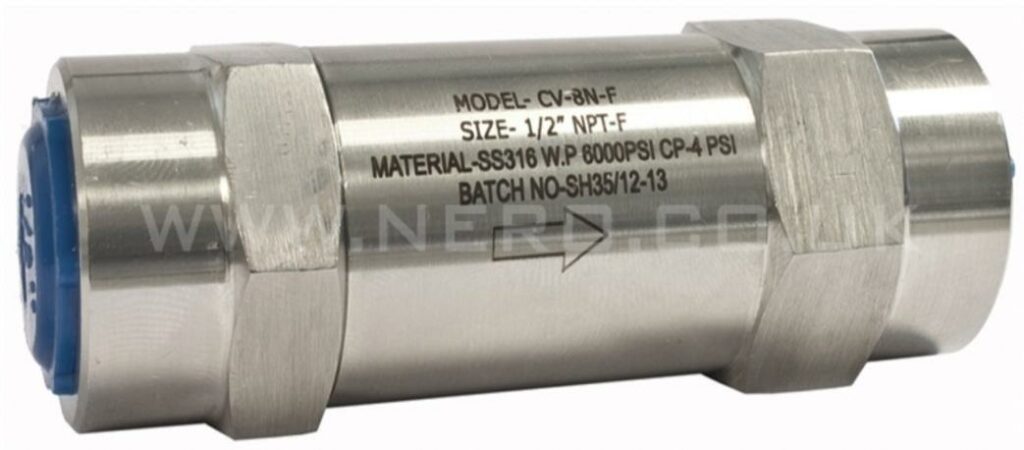
Courtesy: oilybits.com
Check Valves Usages:
- To protect the system from being harmed by a backflow of fluid.
- To ensure that contamination does not occur as a result of fluid backflow.
- To prevent a pipeline from being siphoned.
- To keep the vacuum seal intact.
Check Valves Pros:
- Preventing backflow
- able to withstand changes in pressure
- The ability to be utilized both horizontally and vertically as a safety net
- Prevent backflow from damaging pumps and compressors.
- To minimize downtime and productivity losses,
- Maintain a lower rate of valve failures.
- Maintaining a property at a lower cost
- Reduced environmental impact.
- Adaptable to a wide range of flow conditions.
Check Valves Cons:
- Avoid pulsing systems at all costs.
- Damage and wear can occur if the closing piece slams shut.
- Working in a system that is enclosed.
- There is no way to inspect internal components.
- When a disc is in an open position, it can become trapped.
- Slamming discs make a lot of noise.
6. Plug Valves:
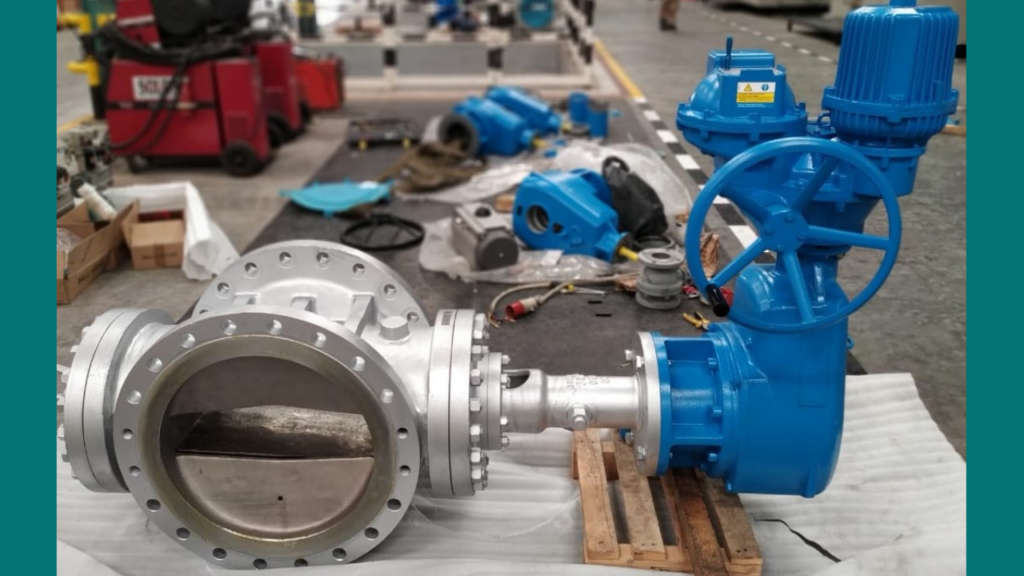
Courtesy: valvulasfevisa.com
A quarter-turn rotational motion is used to stop or start the flow, and a tapered or cylindrical plug is used to stop or start the flow. The disc plug is formed and has a path for the flow to pass through. The plug valve is a bubble-tight shutoff valve that can be used as an on-off stop valve. Plug valves can be utilized in a vacuum for high-pressure and temperature applications.
Types of Plug Valves:
Lubricated Plug Valves:
These valves lower pressure with lubricants or sealants. Occasionally inject lubricant between plug and body seals, and the sealant must tolerate line temperature and polluted fluid. Plastic sealants lubricate plug valves. Use a flexible, chemical-resistant sealant to seal each body component. Lubricant coating reduces plug-to-body corrosion.

Courtesy: pipingengineer.org
Non-Lubricated Plug Valves:
These plug valves are often used on lines with lower pressures. An elastomeric body liner or sleeve is put in the body cavity of these valves. The tapered and polished plug functions as a wedge, pressing the sleeve against the body. As a result, the sleeve reduces the friction between the plug and the body.
Eccentric Plug Valve:

Courtesy: henrypratt.com
This plug valve is half-plugged, and this design aids applications requiring a higher seating force with little open-to-close friction. Torque-seated valves have better shutoff capability. Eccentric plug valves control flow and isolate fluids. Clean and unclean water, sewage, sludge, air, and other services use eccentric plug valves.
Expanding Plug Valve:
This type of plug valve spins between open and closed to protect both seals from the flow. The body and seals don’t touch during rotation, preventing seal wear.
Plug Valves Usages:
- even in moderate vacuum systems, directional flow control
- for efficient gas and liquid fuel handling
- for the safe handling of high-temperature fluids such as boiler feed water, condensate, and other similar materials
- to control the flow of liquids with suspended solids, such as slurries
Plug Valves Pros:
- It is made up of fewer parts and has a straightforward design.
- It can be opened and closed rapidly.
- This valve has a very low flow resistance.
- Using multi-port designs reduces the number of valves required and allows for flow direction changes.
- They are simple to clean and do not require the removal of the body from the piping system.
Plug Valves Cons:
- Because a considerable amount of friction is required to rotate the plug, these valves take more force to function.
- Larger valves necessitate the use of actuators.
- These plug valves are more expensive than similar-looking ball valves.
- The narrowing of the port exacerbates the pressure drop.
7. Pressure Relief Valves:

Courtesy: instrumentationtools.com
A pressure relief valve is utilized during overpressure circumstances to relieve excess pressure from a system, preventing catastrophic failure. As a result, a pressure relief valve is a critical process safety equipment widely employed in the chemical, petrochemical, electricity, and oil and gas industries. The pressure relief valve (PRV) is intended to open when a predetermined set pressure is reached.
Types of Pressure Relief Valves:
Relief Valve:

Courtesy: en.wikiepedia.org
Relief valves are spring-loaded and characterized by slow opening and shutting. They are suitable for incompressible fluids and are actuated by upstream pressure. Adjustable relief valves allow pressure settings to be changed via the outflow port.
Safety Valve:

Courtesy: richter-ct.com
Safety valves prevent steam boilers from overpressure. The quantity of travel or lift during the pop-up divides them into three groups. Low-lift safety valves lift 1/24th of the bore diameter. High-lift safety valves have 1/12th bore diameter. Full-lift safety valves travel 1/4th of the bore diameter and are best for steam.
Safety Relieve Valve:
Depending on the application, the safety relief valve can be utilized for gas or liquid service. It can open quickly or gradually.
Pressure Relief Valves Usages:
Relief valves are employed for smooth petrochemical, electricity, gas, and steam operations; multi-phase applications include chemical processing and refining. Relief valves aren’t needed when high pressure isn’t an issue. Relief valves are closed until upstream pressure reaches the predetermined pressure. When upstream pressure falls below fixed pressure, the valve closes.
Pressure Relief Valves Pros:
- They exhaust the fluid to prevent overpressure in the system.
- They are dependable and adaptable.
- When system pressure returns to normal levels, they reclose and prevent fluid loss.
- The PRV system installation avoids harm to system components.
Pressure Relief Valves Cons:
- Pressure relief caused by back pressure
- If the back pressure is too high, it is prone to chatter.
8. Needle Valves:

Courtesy: thomasnet.com
A needle valve regulates or isolates fluid, and the valve has a Needle-shaped plunger. The plunger’s compact grip allows for accurate valve operation. When fully linked, the valve fits into the appliance’s seat. If a valve is accidentally opened, the distance between the needle and seat is so small that only a small amount of substance can pass through.
Types of Needle Valves:
1. Inline Needle Valve:

Courtesy: exactdesign.co.in
The intake and outflow ports of these valves are in a straight line. Generally, these valves can be fitted in a straight line flow system.
2. Angle Needle Valve:

Courtesy: dialmfg.com
The inlet and output of these valves are at an angle. A 90-degree angle is usually included between the intake and output for improved system integration. This sort of valve is installed where the pipe bends.
Needle Valve Usages:
- All analog field instruments contain a needle valve
- To control the flow of movement. The needle valve can function as an on/off and throttle valve.
- It can be used for metering applications such as steam, air, gas, oil, or water.
- Needle valves are useful in situations where the flow must be stopped gradually.
- A needle valve is useful for sampling points in pipelines where a low flow rate is required.
- Needle valves are utilized in automated combustion control systems where precise flow regulation is required.
- It is used with constant pressure pump governors to eliminate pump discharge variability.
Needle Valve Pros:
- It is simple to use.
- Flow control at a low rate with improved accuracy is feasible with the help of this valve.
- Needle valves are much smaller. As a result, there is no space constraint during installation.
- Flow rates can be accurately adjusted.
- This valve allows for throttling even with a small amount of fluid.
Needle Valve Cons:
- These valves do not allow for immediate opening or closing. Primary operations may cause harm to the seat of the required valve.
- Because of the significant fluid flow restriction, there is a substantial pressure loss in the needle valve.
- They are only suitable for low flow rate piping systems.
- The seat and needle may be damaged if the fluid contains solid particles.
- It is impossible to simply tell whether it is open or closed by looking at the handle position.
9. Pinch Valves:
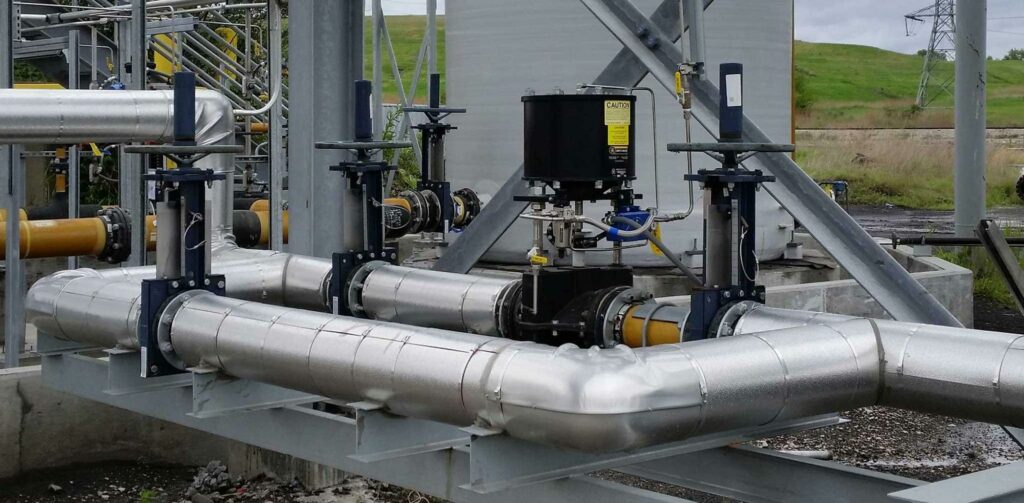
Courtesy: fluidhandlingpro.com
A pinch valve is a flex-body valve with a flexible tube that may be mechanically pulled together or “pinched” to establish a full closure of the flow passage by a mechanism or fluid pressure. These valves’ flow passages are straight, with no fissures or moving elements. The soft body of the pinch valves can close around the trapped solids. Because of this, pinch valves are useful for handling slurries, foodstuffs, and pharmaceuticals. Other industries where pinch valves are used include:
Types of Pinch Valves:
Open Pinch Valves:
Mechanically pinched valves are typically open, with no metal body casing. The open construction of pinch valves is used to visually and physically inspect the valve body during operation. Although this is the most basic form, the liner is exposed to the elements.

Courtesy: shdreamax.com
Enclosed Pinch Valve:

Courtesy: shdreamax.com
Enclosed-body pinch valves resemble globe valves from the outside. The housing protects the liner by acting as a shell. The pinching mechanism is housed within the steel enclosure.
Pinch Valves Usages:
It is appropriate for handling slurries, liquids with substantial concentrations of suspended solids, and pneumatically conveyed solid material.
Pinch Valves Pros:
- It can be utilized when the fluid is prone to corrosion or metal contamination. There are no obstructions in the flow from the valve.
- Maintenance is minimal because there are no interior moving parts in contact with the fluid.
- Due to its simple design, it is inexpensive.
Pinch Valves Cons:
- It cannot be used in high-temperature-pressure applications and gas media.
What is the Most Common Valve used in Industry?
Globe Valves are one of the most common types of valves used in various applications in Industry. These valves, like gate valves, use linear motion to throttle flow. They regulate the flow in a pipeline by the position of a moveable disc (or plug) about the stationary ring seat. A globe valve’s key advantage is that it does not leak as much as other valves.
Conclusion:
Valves are mechanical devices that open, close, or partially restrict the flow of water to control, direct, and regulate it. They can be made of many materials such as bronze, PVC, brass, etc. Depending on the requirements, different plumbing valves are used in pipes. Plumbing valves in a pipe system cost between 20 and 30 percent of the total piping cost. And the price of a given type and size of plumbing valve can vary by 100%.

